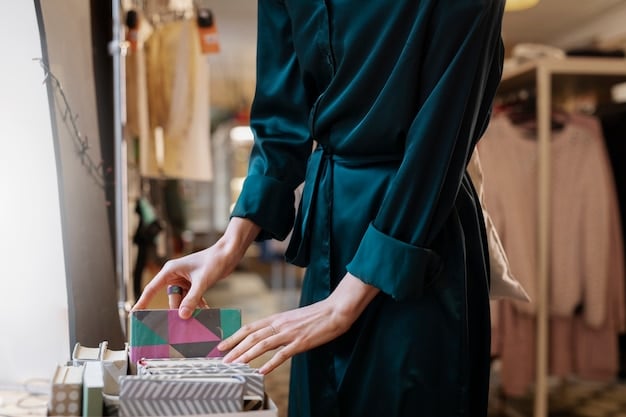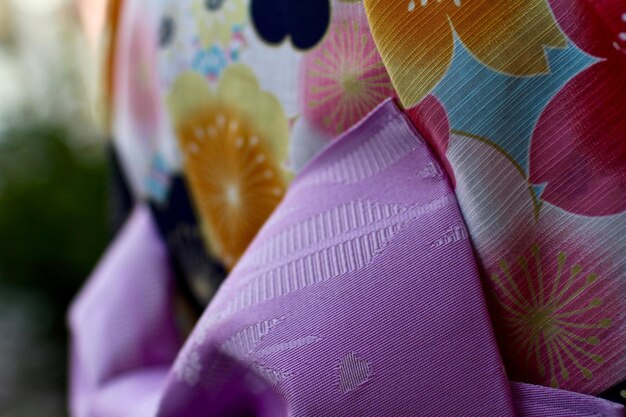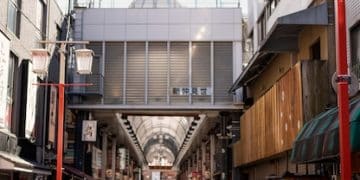The Secret to Finding Authentic Kimonos: A Shopper’s Guide for the US

Finding an authentic kimono involves understanding its materials, construction, history, and cultural significance, ensuring US shoppers acquire a garment that is both a beautiful piece of clothing and a valuable cultural artifact.
Embarking on a quest to find an authentic kimono can feel like stepping into a rich tapestry of Japanese history and artistry. This guide unveils the secret to finding authentic kimonos: a US shopper’s guide to identifying quality and value, ensuring you acquire a timeless piece that resonates with tradition and elegance.
The Allure of Authentic Kimonos
The allure of authentic kimonos extends far beyond their aesthetic appeal. They represent centuries of Japanese tradition, craftsmanship, and cultural identity. Understanding the history and significance of these garments is crucial for appreciating their true value.
A Brief History of Kimonos
The kimono’s origins can be traced back to the Heian period (794-1185), evolving from Chinese Han clothing. Over centuries, it transformed into the iconic garment we recognize today, becoming a symbol of refinement and social status.
The Cultural Significance of Kimonos
Kimonos are deeply embedded in Japanese culture, worn during significant life events such as weddings, tea ceremonies, and festivals. Each aspect, from the fabric to the motifs, carries symbolic meaning, reflecting the wearer’s age, marital status, and the occasion.
In contemporary fashion, kimonos have transitioned from strict ceremonial wear to expressions of personal style. They can be seen as statement pieces, blending traditional aesthetics with modern sensibilities. This fusion is what makes them continually captivating.
- Weddings: Kimonos symbolize purity and good fortune.
- Tea Ceremonies: They represent respect and harmony.
- Festivals: They showcase community spirit and celebration.
Ultimately, the allure of authentic kimonos lies in their ability to bridge the past and present, offering a tangible connection to Japanese heritage and an opportunity to explore timeless elegance. Understanding their historical and cultural context enriches the experience of owning and wearing these exquisite garments, making them more than just clothing, but cherished pieces of art.
Understanding the Materials of Authentic Kimonos
To discern an authentic kimono from a replica, it’s essential to understand the materials used in their construction. Traditional kimonos are crafted from high-quality natural fibers, each with its distinct characteristics and significance.
Silk: The Quintessential Kimono Fabric
Silk is the most prized material for kimonos, celebrated for its luxurious feel, vibrant color retention, and elegant drape. High-quality silk kimonos are often hand-painted or dyed, showcasing intricate designs and impeccable craftsmanship.
Other Common Materials
While silk is the gold standard, other materials like cotton, linen, and wool also have their place in kimono production, particularly for more casual or everyday wear. Each material offers unique benefits and textures.
Identifying High-Quality Fabrics
When examining a kimono, look for tight weaves, even textures, and rich colors that indicate high-quality materials. Silk should feel smooth and supple, while cotton and linen should be durable and well-finished.
Different materials lend themselves to particular styles and seasons. Silk kimonos are often reserved for formal occasions, while cotton kimonos (yukata) are popular for summer festivals. Understanding these distinctions will guide your choices.
- Silk: Look for a luxurious sheen and intricate designs.
- Cotton: Opt for durable weaves and comfortable textures.
- Linen: Appreciate its breathability and natural feel.
Being able to identify these distinctions ensures that any kimono purchase isn’t based solely on aesthetics, but also on a clear understanding of materials that define its nature. It also allows one to better judge value for money and preservation protocol.

Decoding Kimono Patterns and Motifs
Kimonos are adorned with elaborate patterns and motifs that carry deep symbolic meanings. These designs offer insights into the kimono’s history, the wearer’s status, and the occasions for which it is appropriate.
Traditional Motifs and Their Meanings
Classic kimono motifs include floral patterns like cherry blossoms (sakura), which symbolize the fleeting nature of life, and pine trees (matsu), representing longevity. Other common motifs include cranes (tsuru), emblems of good fortune, and water patterns, signifying purity and renewal.
Regional Variations in Design
Different regions of Japan often have their own distinctive kimono designs and dyeing techniques. For instance, Kyoto is renowned for its yuzen dyeing, while Okinawa is known for its bingata patterns.
Recognizing Modern Interpretations
While traditional motifs remain popular, modern kimonos may feature contemporary designs and abstract patterns, reflecting evolving fashion trends and personal expressions.
Paying attention to these patterns can tell an expansive story. What an external observer may consider ‘pretty’ design choices reflect cultural storytelling and historical significance. Deciphering the elements ensures a kimono isn’t a simple statement but a wearable piece of history.
- Floral Patterns: Symbolize seasons and personal attributes.
- Animal Motifs: Represent virtues and auspiciousness.
- Geometrical Designs: Denote stability and order.
Understanding all design choices enriches appreciation and ensures the preservation of the piece for generations. With greater understanding, a modern-day observer honors artisans past and their culture’s present.
Spotting Signs of Authentic Craftsmanship
Authentic kimonos are characterized by meticulous craftsmanship, reflecting the skill and dedication of the artisans who create them. Recognizing these signs of quality is essential for identifying a genuine piece.
Hand-Stitching vs. Machine-Made
Hand-stitched kimonos exhibit subtle variations and irregularities that testify to their artisanal origin. Machine-made kimonos, on the other hand, tend to have uniform stitching and lack the unique character of handmade items.
Dyeing and Painting Techniques
Traditional dyeing and painting techniques, such as yuzen and shibori, result in vibrant, nuanced colors and intricate patterns. These methods require years of training and practice, making them hallmarks of authentic craftsmanship.
Attention to Detail
Examine details such as the seams, the lining, and the collar for signs of careful construction. Authentic kimonos often have reinforced seams and meticulously finished edges, ensuring durability and aesthetic appeal.
Being able to identify such craftsmanship ensures that one doesn’t merely acquire a garment but also supports cultural heritage. The value isn’t based on mere aesthetics, but sustainable art practices.
- Stitching Quality: Look for even, tight stitches and reinforced seams.
- Dyeing Techniques: Appreciate the depth and richness of natural dyes.
- Finishing Touches: Notice the care and precision in every detail.
Ultimately, spotting signs of authentic craftsmanship underscores the dedication necessary for production, honoring not simply the end product but also the journey that led to its creation.
Where to Shop for Authentic Kimonos in the US
Finding authentic kimonos in the US requires a discerning eye and a willingness to explore various shopping venues. Whether you prefer the thrill of vintage hunting or the assurance of established retailers, several options cater to different tastes and budgets.
Antique Stores and Vintage Shops
Antique stores and vintage shops can be treasure troves for finding unique and well-preserved kimonos. These venues often offer a wide range of styles, from antique heirlooms to more recent pieces.
Specialty Retailers and Boutiques
Specialty retailers and boutiques specializing in Japanese clothing and textiles are another excellent source for authentic kimonos. These establishments typically curate high-quality pieces and offer expert advice.
Online Marketplaces and Auctions
Online marketplaces and auctions can provide access to a diverse selection of kimonos from around the world. However, it’s essential to exercise caution and thoroughly research sellers before making a purchase.
Ultimately, the shopping locations reflect personal preferences, making the selection journey dynamic. However, the overall principle remains focused on authenticity and value.

Tips for Online Shopping
When shopping online, look for detailed descriptions, high-resolution photos, and transparent seller policies. Don’t hesitate to request additional information or ask questions about the kimono’s provenance and condition.
- Check Reviews: Look for sellers with positive feedback and transparent policies.
- Verify Authenticity: Request detailed descriptions and photos.
- Compare Prices: Ensure you are getting a fair deal for the quality.
Navigating these shopping channels ensures informed purchasing and greater product appreciation. It also helps modern aficionados connect with art history in meaningful ways.
Caring for Your Kimono: Preservation Tips
Proper care is essential for preserving the beauty and integrity of your kimono. Whether you own a vintage heirloom or a contemporary piece, following these preservation tips will help ensure its longevity.
Storage Solutions
Store your kimono in a cool, dry place away from direct sunlight and humidity. Use acid-free paper or fabric to protect it from dust and pests.
Cleaning and Maintenance
Avoid washing your kimono at home, as harsh detergents and improper techniques can damage the delicate fabrics. Instead, opt for professional dry cleaning or spot cleaning as needed.
Handling Precautions
When handling your kimono, always wash your hands and avoid wearing jewelry or accessories that could snag the fabric. Be gentle and mindful of its delicate nature.
Maintenance involves respecting the kimono’s origin and craftsmanship. The care and precision applied during the creation of the garments reflect the care and precision of its handling. By following preservation tips, owners do more than simply maintain textiles; they nurture art history.
- Professional Cleaning: Entrust your kimono to experts familiar with delicate fabrics.
- Safe Storage: Protect it from environmental damages.
- Careful Handling: Treat it with the respect it deserves.
Ultimately, handling precision facilitates kimono longevity, enabling stories to be passed down across generations. It’s a matter of preserving aesthetic and cultural significance.
Assessing Value and Making Informed Decisions
Determining the value of a kimono requires considering various factors, including its age, condition, materials, and craftsmanship. By assessing these elements, you can make informed decisions and ensure you are paying a fair price.
Factors Influencing Kimono Value
Antique kimonos in excellent condition, crafted from high-quality silk and adorned with intricate designs, tend to command higher prices. Additionally, kimonos made by renowned artisans or featuring rare techniques are highly valued.
Setting a Budget
Before embarking on your kimono quest, determine a realistic budget based on your preferences and financial constraints. This will help you narrow down your options and avoid overspending.
Negotiating Prices
Don’t hesitate to negotiate prices, especially when shopping at antique stores or vintage shops. Be respectful but assertive, and be prepared to walk away if the price doesn’t align with your budget and expectations.
In conclusion, value assessments entail understanding the financial and cultural implications. Being informed ensures appreciation for tradition while avoiding overspending on items for cultural preservation.
- Assess Quality: Look closely at materials, stitching, and overall condition.
- Compare Prices: Research similar items to gauge market value.
- Trust Your Instincts: Choose a kimono that resonates with you personally.
Informed decisions ensure both appreciation of heritage and financial confidence. Owners don’t just acquire garments but consciously participate in cultural preservation.
| Key Point | Brief Description |
|---|---|
| 👘 Authenticity | Learn to identify genuine materials and craftsmanship for an authentic purchase. |
| 🌿 Material | Recognize high-quality silk, cotton, and linen to ensure durability and comfort. |
| 🌸 Patterns | Decipher traditional motifs and designs to understand cultural significance. |
| 💰 Value | Assess factors like age, condition, and craftsmanship for a fair price. |
FAQ
▼
An authentic kimono is typically defined by its hand-stitched construction, high-quality natural materials like silk or cotton, and traditional dyeing techniques. Designs and motifs often have cultural and historical significance.
▼
High-quality silk in a kimono should feel smooth and supple, with a luxurious sheen. The fabric should drape well and retain vibrant colors. Check for tight weaves and intricate patterns indicative of expert craftsmanship.
▼
Yes, vintage kimonos can be a great option. They often offer unique designs and historical value. Be sure to carefully inspect the condition of the kimono and verify its authenticity before purchasing.
▼
Common motifs include cherry blossoms (sakura), which symbolize the fleeting nature of life, cranes (tsuru) for good fortune, and pine trees (matsu) for longevity. Regional variations in design can also be significant.
▼
Store your kimono in a cool, dry place away from direct sunlight. Use acid-free paper or fabric to protect it. Avoid washing at home; opt for professional dry cleaning and handle the kimono with clean hands.
Conclusion
Navigating the world of authentic kimonos for US shoppers involves understanding materials, craftsmanship, and cultural significance. Equipped with this knowledge, you can confidently select a valuable piece that reflects timeless elegance and rich tradition.





